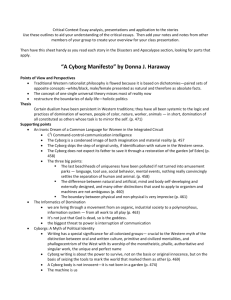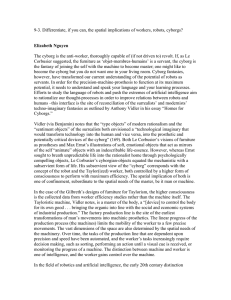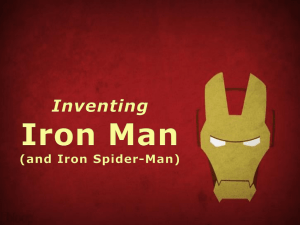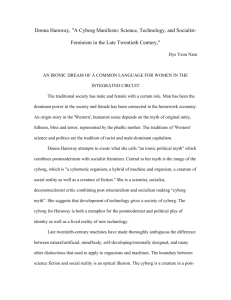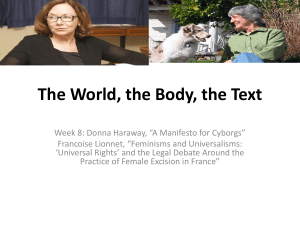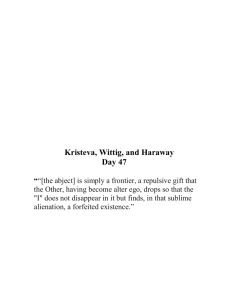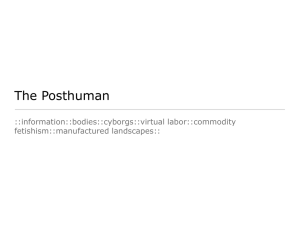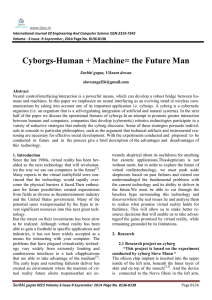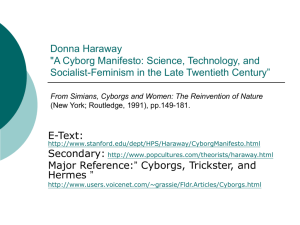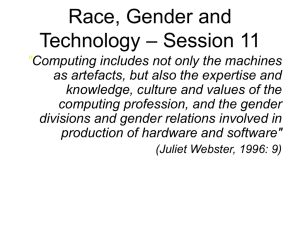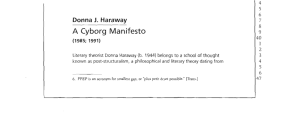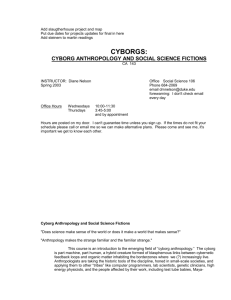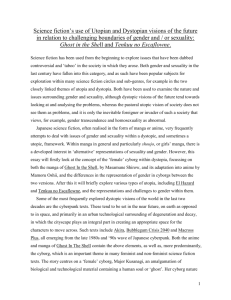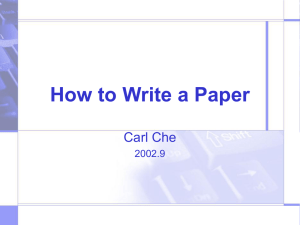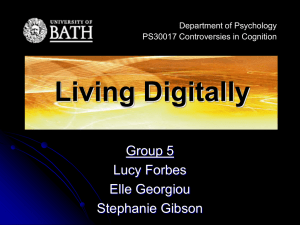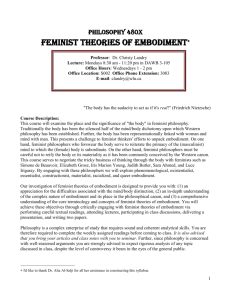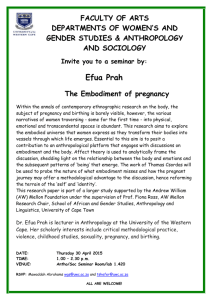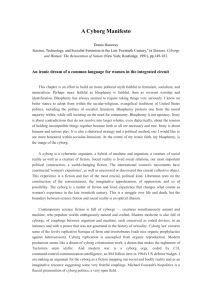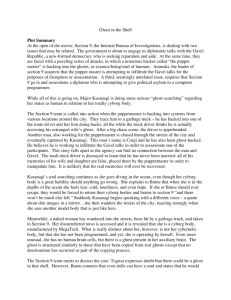Excerpts from Donna Haraway`s "A Manifesto for Cyborgs" (1991)
advertisement
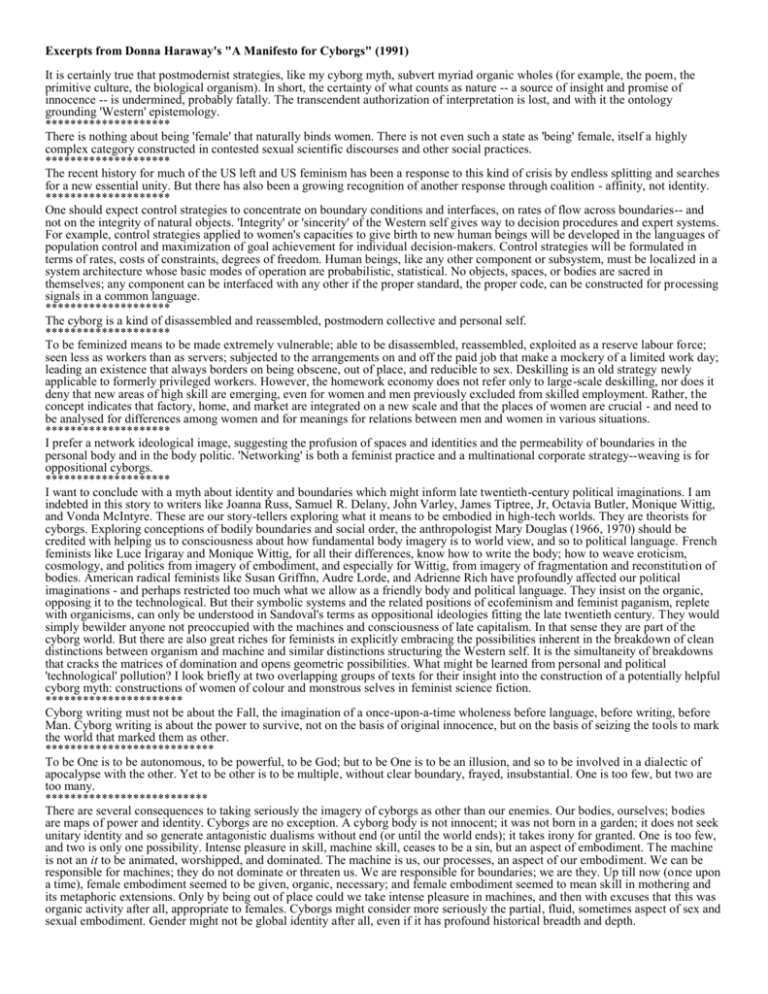
Excerpts from Donna Haraway's "A Manifesto for Cyborgs" (1991) It is certainly true that postmodernist strategies, like my cyborg myth, subvert myriad organic wholes (for example, the poem, the primitive culture, the biological organism). In short, the certainty of what counts as nature -- a source of insight and promise of innocence -- is undermined, probably fatally. The transcendent authorization of interpretation is lost, and with it the ontology grounding 'Western' epistemology. ******************** There is nothing about being 'female' that naturally binds women. There is not even such a state as 'being' female, itself a highly complex category constructed in contested sexual scientific discourses and other social practices. ******************** The recent history for much of the US left and US feminism has been a response to this kind of crisis by endless splitting and searches for a new essential unity. But there has also been a growing recognition of another response through coalition - affinity, not identity. ******************** One should expect control strategies to concentrate on boundary conditions and interfaces, on rates of flow across boundaries-- and not on the integrity of natural objects. 'Integrity' or 'sincerity' of the Western self gives way to decision procedures and expert systems. For example, control strategies applied to women's capacities to give birth to new human beings will be developed in the languages of population control and maximization of goal achievement for individual decision-makers. Control strategies will be formulated in terms of rates, costs of constraints, degrees of freedom. Human beings, like any other component or subsystem, must be localized in a system architecture whose basic modes of operation are probabilistic, statistical. No objects, spaces, or bodies are sacred in themselves; any component can be interfaced with any other if the proper standard, the proper code, can be constructed for processing signals in a common language. ******************** The cyborg is a kind of disassembled and reassembled, postmodern collective and personal self. ******************** To be feminized means to be made extremely vulnerable; able to be disassembled, reassembled, exploited as a reserve labour force; seen less as workers than as servers; subjected to the arrangements on and off the paid job that make a mockery of a limited work day; leading an existence that always borders on being obscene, out of place, and reducible to sex. Deskilling is an old strategy newly applicable to formerly privileged workers. However, the homework economy does not refer only to large-scale deskilling, nor does it deny that new areas of high skill are emerging, even for women and men previously excluded from skilled employment. Rather, the concept indicates that factory, home, and market are integrated on a new scale and that the places of women are crucial - and need to be analysed for differences among women and for meanings for relations between men and women in various situations. ******************** I prefer a network ideological image, suggesting the profusion of spaces and identities and the permeability of boundaries in the personal body and in the body politic. 'Networking' is both a feminist practice and a multinational corporate strategy--weaving is for oppositional cyborgs. ******************** I want to conclude with a myth about identity and boundaries which might inform late twentieth-century political imaginations. I am indebted in this story to writers like Joanna Russ, Samuel R. Delany, John Varley, James Tiptree, Jr, Octavia Butler, Monique Wittig, and Vonda McIntyre. These are our story-tellers exploring what it means to be embodied in high-tech worlds. They are theorists for cyborgs. Exploring conceptions of bodily boundaries and social order, the anthropologist Mary Douglas (1966, 1970) should be credited with helping us to consciousness about how fundamental body imagery is to world view, and so to political language. French feminists like Luce Irigaray and Monique Wittig, for all their differences, know how to write the body; how to weave eroticism, cosmology, and politics from imagery of embodiment, and especially for Wittig, from imagery of fragmentation and reconstitution of bodies. American radical feminists like Susan Griffnn, Audre Lorde, and Adrienne Rich have profoundly affected our political imaginations - and perhaps restricted too much what we allow as a friendly body and political language. They insist on the organic, opposing it to the technological. But their symbolic systems and the related positions of ecofeminism and feminist paganism, replete with organicisms, can only be understood in Sandoval's terms as oppositional ideologies fitting the late twentieth century. They would simply bewilder anyone not preoccupied with the machines and consciousness of late capitalism. In that sense they are part of the cyborg world. But there are also great riches for feminists in explicitly embracing the possibilities inherent in the breakdown of clean distinctions between organism and machine and similar distinctions structuring the Western self. It is the simultaneity of breakdowns that cracks the matrices of domination and opens geometric possibilities. What might be learned from personal and political 'technological' pollution? I look briefly at two overlapping groups of texts for their insight into the construction of a potentially helpful cyborg myth: constructions of women of colour and monstrous selves in feminist science fiction. ********************** Cyborg writing must not be about the Fall, the imagination of a once-upon-a-time wholeness before language, before writing, before Man. Cyborg writing is about the power to survive, not on the basis of original innocence, but on the basis of seizing the tools to mark the world that marked them as other. *************************** To be One is to be autonomous, to be powerful, to be God; but to be One is to be an illusion, and so to be involved in a dialectic of apocalypse with the other. Yet to be other is to be multiple, without clear boundary, frayed, insubstantial. One is too few, but two are too many. ************************** There are several consequences to taking seriously the imagery of cyborgs as other than our enemies. Our bodies, ourselves; bodies are maps of power and identity. Cyborgs are no exception. A cyborg body is not innocent; it was not born in a garden; it does not seek unitary identity and so generate antagonistic dualisms without end (or until the world ends); it takes irony for granted. One is too few, and two is only one possibility. Intense pleasure in skill, machine skill, ceases to be a sin, but an aspect of embodiment. The machine is not an it to be animated, worshipped, and dominated. The machine is us, our processes, an aspect of our embodiment. We can be responsible for machines; they do not dominate or threaten us. We are responsible for boundaries; we are they. Up till now (once upon a time), female embodiment seemed to be given, organic, necessary; and female embodiment seemed to mean skill in mothering and its metaphoric extensions. Only by being out of place could we take intense pleasure in machines, and then with excuses that this was organic activity after all, appropriate to females. Cyborgs might consider more seriously the partial, fluid, sometimes aspect of sex and sexual embodiment. Gender might not be global identity after all, even if it has profound historical breadth and depth.
